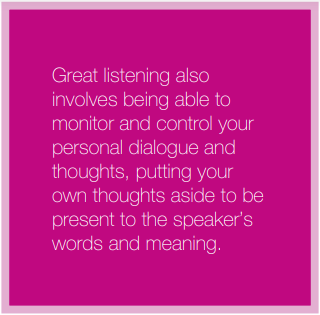Listening with Understanding and Empathy
Practical Ways to Build this Habit in the Classroom
Listening with understanding and empathy is a crucial skill that not only enhances personal relationships but also plays a significant role in academic and professional lives. The Habit of Mind of Listening with Understanding and Empathy, as identified by Prof Art Costa and Dr Bena Kallick, goes beyond simply hearing words; it involves actively engaging with the speaker, seeking to comprehend their perspective and responding with genuine empathy. Great listening also involves being able to monitor and control your personal dialogue and thoughts, putting your own thoughts aside to be present to the speaker’s words and meaning.
In the classroom, teaching students to listen with understanding and empathy can be a transformative
experience, fostering a more inclusive and compassionate learning environment. Here are some practical ways to teach this skill and habit in the classroom.
Active Listening Exercises
Create opportunities to practice active listening exercises. When students are discussing or brainstorming in pairs or small groups, invite them to share what they heard and learned with the class.

 Attending to the Physical
Attending to the Physical
Explicitly teach students to notice and monitor the physical features of a speaker while they are listening. This takes practice. Practice seeing a speaker’s facial expressions, body language and eye movements. Also cue them into understanding voice intonation and what this may mean.
Teach the Listening Sequence
The three P’s of listening are Pause, Paraphrase and Probe.
• Pause: When the other person finishes speaking, wait for a few moments, ideally between 7-10 seconds! Ask yourself, “Has the other person really finished?” Sometimes waiting is the most helpful thing to do, rather than jumping in with your opinion. In that quiet space, the other person may clarify or reframe their point of view, solution or idea.
• Paraphrase: Summarise what you heard them say. This is a brief explanation that represents what was told to you. This is not the time to add your thinking, inferences or new ideas.
• Probe: Ask questions to promote clarity and precision of the other person’s point of view, solution or idea.
This can aid others in understanding their own thinking better. Questioning helps to eliminate ambiguity and ensure effective communication. Here are some examples of clarifying questions:
– Can you please explain that in more detail?
– What specifically do you mean by xyz?
– I’m not sure I understand. Can you walk me through it step by step?
– Can you give an example to illustrate your point?
Be Curious
One of the fastest ways to teach students great listening skills is to authentically model them. Show students you are interested in finding out more about what they say or their reasonings. Use phrases such as, “Tell me more,” and, “What makes you say that?”
Role Play and Perspective-Taking
Role-play activities help students see the world from different perspectives. Assign roles and scenarios that challenge students to understand and empathise with characters who have diverse backgrounds, experiences and viewpoints. Debrief after the role-play to discuss the importance of empathy in understanding others.
Reflective Journals
Implementing reflective journaling in your classroom can be a powerful tool for teaching listening with understanding and empathy. Have students write about their experiences of actively listening to others, sharing their insights, challenges and personal growth. This practice helps them become more self-aware and encourages continuous improvement.
Guest Speakers and Real-World Application
Invite guest speakers to share their experiences and perspectives with your class. Encourage students to actively listen, take notes and ask thoughtful questions. Afterwards, discuss what they learned and how it increased their understanding and empathy for different perspectives in the real world.

Empathy-Building Literature
Incorporate literature that focuses on empathy and understanding into your curriculum. Novels, short stories and poetry can provide valuable opportunities for students to explore and discuss characters’ emotions and perspectives. Encourage students to write essays or engage in discussions to deepen their understanding of empathy.
Teaching the Habit of Mind and then listening with understanding and empathy, is a valuable investment in your student’s personal growth and academic success. By fostering connection, enhancing learning and developing emotional intelligence, this skill equips students with the tools they need to navigate a diverse and interconnected world. Incorporating active listening exercises, role-play, reflective journals, guest speakers and empathy-building literature can help you instill this essential habit in your classroom, preparing your students to become empathetic, open-minded and compassionate individuals.
As Professor Art Costa says, “What if everyone in the world listened with understanding and empathy? The world would be a very different place!”
Published on Friday, November 24th, 2023, under Habits of Mind
